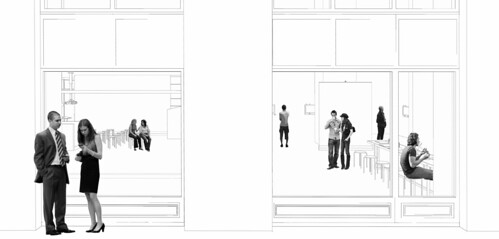agglomeration of empty shops
dpr barcelona dedicated a post about the Agglomeration of Empty Shops, one last semi-realized project by Antonas office. The project belongs to a system of works that are related to the athenian decline and to some answers to it. The concept of protocol is crucial in this collection of projects. The agglomeration of Empty Shops treats areas of the city center where a multitude of small shops is closed during the Greek financial disaster. The empty shops did not belong at a singular project in the past; they were situated in a linear system of athenian arcades. In the past, the proprietors or the renters decided the nature of the business that was placed at every spot. The agglomeration of the empty shops would programmatically include the (abandoned and empty now) small spaces into a single project. Even if the agglomeration does not offer a continuous experience, the project was undertaken with the ambition that the first impression of a random passage through the arcades would give the impression of a single decision operated in a number of rooms.

The occupation of the empty shops would have to perform at a first level by a unifying logic. A space of an open ad hoc university or a system of discussion rooms or equipped rooms for temporary shows could transform this linear spaces to a multiple, different entity. At a second level what had to be secured was the mere multiplicity of this fragmentary space; it had to be again guaranteed as an important part of the intervention. A non-homogeneous functionality would be necessarily programmed in the complex project space. An unusual urban curating had to define the unified intervention, curate the unity of the intention, organize and colonize the empty space and, in the same move, keep the scale of the small shops. An accurate and complex programming would be here analogue to an idiosyncratic, public curatorial work where the functions of the spaces and their time sequences are decided.

The functions that can occur in these empty shops follows the most flexible rationale; they can be used as possible places for many different, idiosyncratic, legal occupancies. They are not proposed for a specific program but as a question about program. The structure of the void is here elaborated out of the knowledge of simple furniture and out of their particular placing. The simple material shape structures the void and characterizes the architecture. The construction of a field of space receptacles or cases ("thekae" in Greek) that have not yet any specific meaning proposes a concrete way to formulate an abstract condition. The field of the space receptacles will receive some actions to be decided afterwards. Nevertheless, the receptacle already traces the structure of this program of reception. The form of the void condenses an architectonic way of thinking about space. It goes against Sullivan leit motiv “form follows function” by claiming ironically that form generates different functions. The architecture of void is conceived thus (for the needs of such a parallelism) as the mold which creates the conditions for a predetermined abstract possibility of the visitor’s movement and stasis. This interior promenade of the visitor would allow to different functions to take place. The constructed void organizes the awaiting character of the installation, directs the walk and prepares the behavior of the visitor. Architecture through such a point of view would form the idiosyncratic empty field that orients prepared abstract receptions of visitors according to its form. But this field is only the pentagram on which different functions would perform different sound results.

[ Part of the “Agglomeration of Empty Shops” was realized in the center of Athens by the Onassis Foundation for the needs of its Open Lab installation in January 2014. In the empty rooms of 19 abandoned shops of an Arcade were constructed hospitable free Internet spaces where visitors could rest or work; many discussions and meetings took place while in other rooms of the installation were exhibited technical drawings of proposed projects, undertaken in the center of Athens. ]





No comments:
Post a Comment